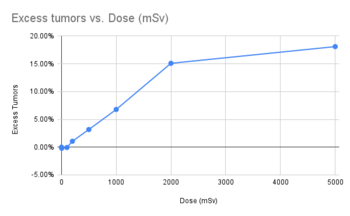Talk:Fear of radiation: Difference between revisions
imported>David MacQuigg No edit summary |
imported>David MacQuigg No edit summary |
||
| Line 14: | Line 14: | ||
For those who care about these small risks (regulators and a fearful public) I would say we should think of this as we do about buying a car. If I had to choose between a car I really wanted, and one that had a safety rating a little better (20% chance of an injury in an accident, vs 21%) I would take that extra risk. I might do a little study and find out exactly what the problem is with the car I like, and take steps to avoid that problem. | For those who care about these small risks (regulators and a fearful public) I would say we should think of this as we do about buying a car. If I had to choose between a car I really wanted, and one that had a safety rating a little better (20% chance of an injury in an accident, vs 21%) I would take that extra risk. I might do a little study and find out exactly what the problem is with the car I like, and take steps to avoid that problem. | ||
So on the nuclear power question, if I was considering buying a home I really liked near a nuclear plant or spent fuel storage site, I might do a little study and assure myself that the chances of an accident are small, and then the chances of a radiation leak are even smaller, and then the chances of that leak giving me an exposure like the Japanese bomb survivors are so small that I would better spend my time worrying about getting hit by a meteor. | So on the nuclear power question, if I was considering buying a home I really liked near a nuclear plant or spent fuel storage site, I might do a little study and assure myself that the chances of an accident are small, and then the chances of a radiation leak are even smaller, and then the chances of that leak giving me an exposure like the Japanese bomb survivors are so small that I would better spend my time worrying about getting hit by a meteor. [[User:David MacQuigg|David MacQuigg]] ([[User talk:David MacQuigg|talk]]) 19:42, 16 December 2021 (UTC) | ||
Revision as of 13:42, 16 December 2021
LNT Controversy
There is endless debate in social media over whether the Linear No Threshold (LNT) model should be used for accessing public health risks from low levels of radiation. Fig.A is the data of Fig.1 from a 52 year study of Japanese bomb survivors, with added columns for a linear fit and for the predicted excess tumors.
Fig.B is the data re-plotted on a linear scale.
The LNT model is a good fit for exposures above 200mSv, ignoring the highest point, where we might expect some kind of saturation. (A better fit would have the threshold at 100mSv, not zero.)
The controversy is over exposures less than 200mSv. If your exposure is between 5 and 100mSv, LNT predicts your chances of getting cancer are 0.75% higher than the normal 21%. The data from this study shows -0.07% (less cancer, not more).
For those who care about these small risks (regulators and a fearful public) I would say we should think of this as we do about buying a car. If I had to choose between a car I really wanted, and one that had a safety rating a little better (20% chance of an injury in an accident, vs 21%) I would take that extra risk. I might do a little study and find out exactly what the problem is with the car I like, and take steps to avoid that problem.
So on the nuclear power question, if I was considering buying a home I really liked near a nuclear plant or spent fuel storage site, I might do a little study and assure myself that the chances of an accident are small, and then the chances of a radiation leak are even smaller, and then the chances of that leak giving me an exposure like the Japanese bomb survivors are so small that I would better spend my time worrying about getting hit by a meteor. David MacQuigg (talk) 19:42, 16 December 2021 (UTC)

